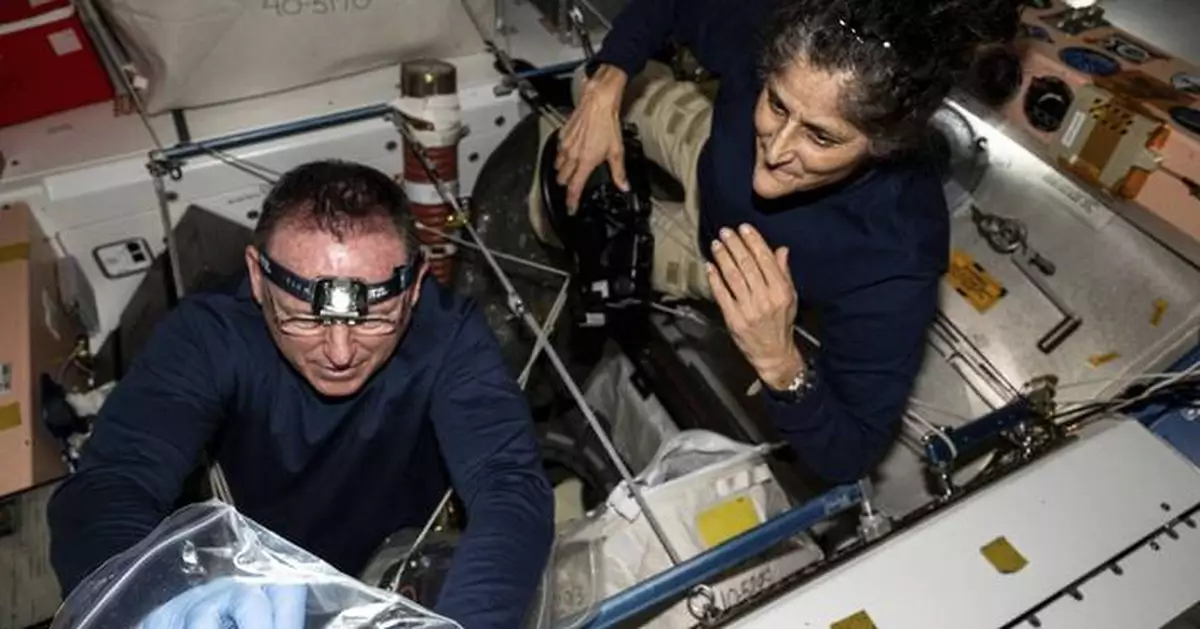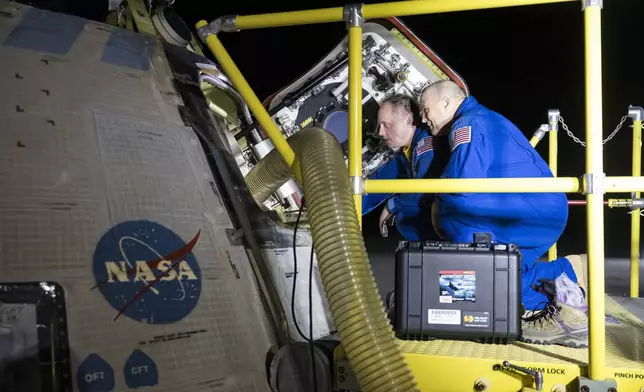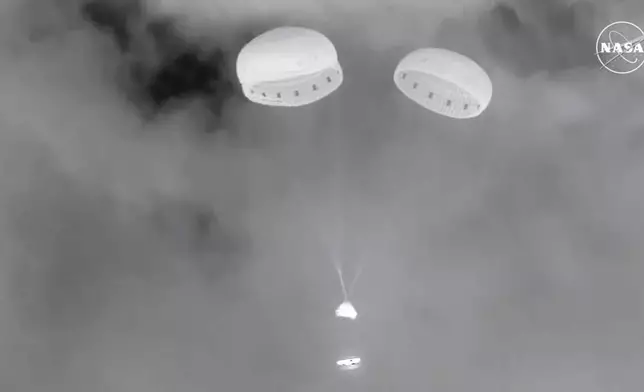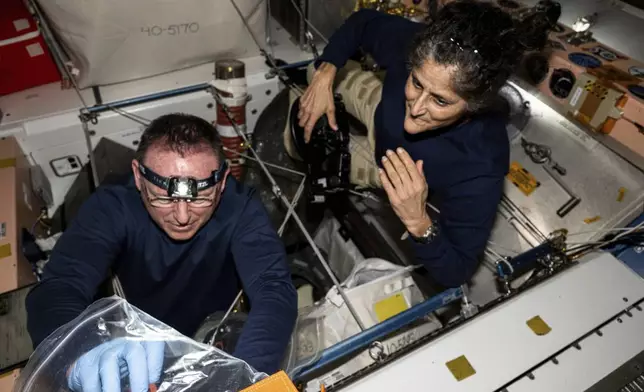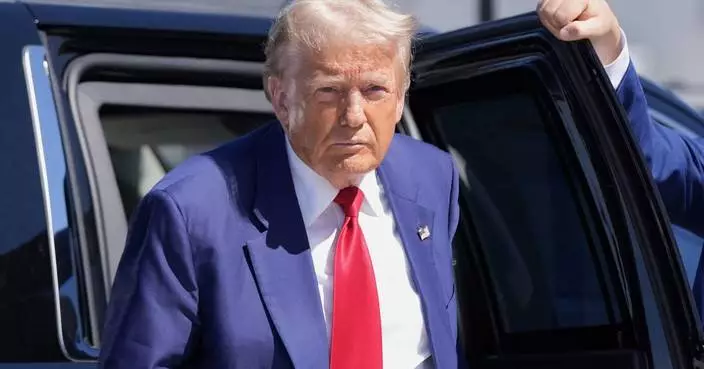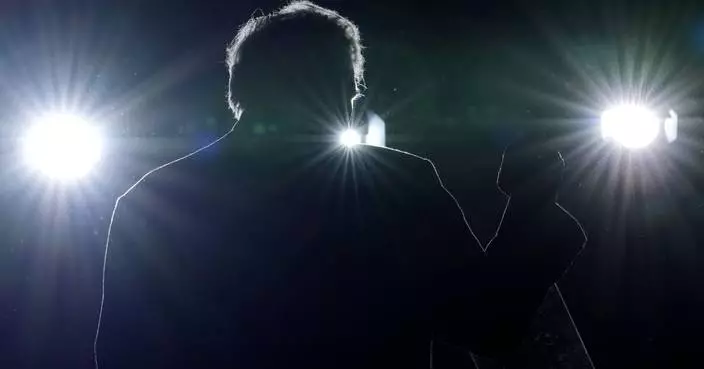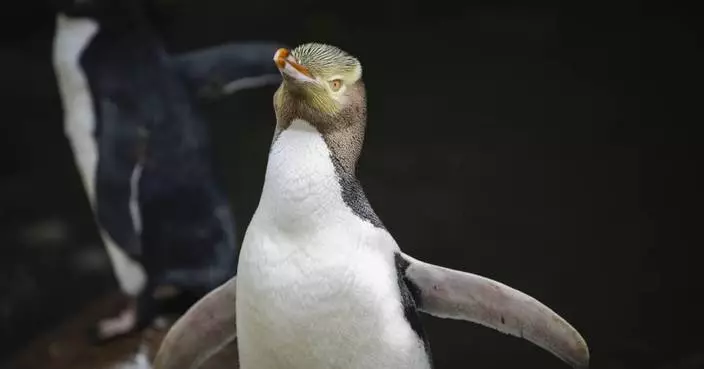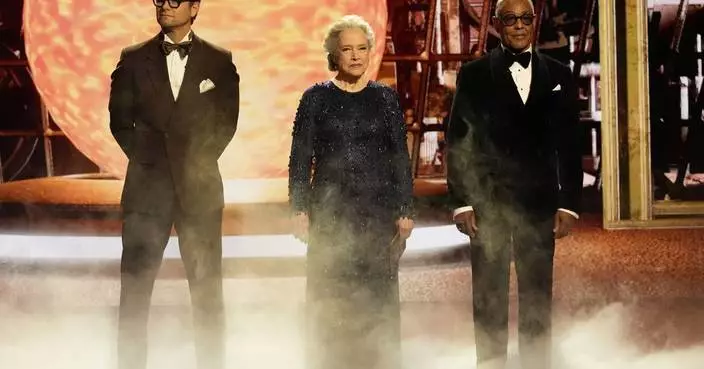Boeing’s first astronaut mission ended Friday night with an empty capsule landing and two test pilots still in space, left behind until next year because NASA judged their return too risky.
Six hours after departing the International Space Station, Starliner parachuted into New Mexico’s White Sands Missile Range, descending on autopilot through the desert darkness.
Click to Gallery
Boeing’s first astronaut mission ended Friday night with an empty capsule landing and two test pilots still in space, left behind until next year because NASA judged their return too risky.
In this photo provided by NASA, Boeing and NASA teams work around NASA's Boeing Crew Flight Test Starliner spacecraft after it landed uncrewed, Friday, Sept. 6, 2024, at White Sands, New Mexico, after undocking from the International Space Station. (Aubrey Gemignani/NASA via AP)
In this photo provided by NASA, Boeing and NASA teams work around NASA's Boeing Crew Flight Test Starliner spacecraft after it landed uncrewed, Friday, Sept. 6, 2024, at White Sands, New Mexico, after undocking from the International Space Station. (Aubrey Gemignani/NASA via AP)
The empty Boeing Starliner capsule sits at White Sands Missile Range in New Mexico, late Friday, Sept. 6, 2024, after undocking from the International Space Station. (Boeing via AP)
In this image from video provided by NASA, the empty Boeing Starliner capsule jettisons its heat shield, bottom, before touching down at White Sands Missile Range in New Mexico late Friday, Sept. 6, 2024, after undocking from the International Space Station. (NASA via AP)
In this image from video provided by NASA, the empty Boeing Starliner capsule floats down towards White Sands Missile Range in New Mexico late Friday, Sept. 6, 2024, after undocking from the International Space Station. (NASA via AP)
In this image from video provided by NASA, the empty Boeing Starliner capsule touches down at White Sands Missile Range in New Mexico late Friday, Sept. 6, 2024, after undocking from the International Space Station. (NASA via AP)
In this image from video provided by NASA, the unmanned Boeing Starliner capsule undocks as it pulls away from the International Space Station on Friday, Sept. 6, 2024. (NASA via AP)
In this image from video provided by NASA, the unmanned Boeing Starliner capsule fires its thrusters as it pulls away from the International Space Station on Friday, Sept. 6, 2024. (NASA via AP)
In this photo provided by NASA, astronauts Butch Wilmore, left, and Suni Williams inspect safety hardware aboard the International Space Station on Aug. 9, 2024. (NASA via AP)
It was an uneventful close to a drama that began with the June launch of Boeing's long-delayed crew debut and quickly escalated into a dragged-out cliffhanger of a mission stricken by thruster failures and helium leaks. For months, Butch Wilmore and Suni Williams’ return was in question as engineers struggled to understand the capsule’s problems.
Boeing insisted after extensive testing that Starliner was safe to bring the two home, but NASA disagreed and booked a flight with SpaceX instead. Their SpaceX ride won’t launch until the end of this month, which means they’ll be up there until February — more than eight months after blasting off on what should have been a quick trip.
Wilmore and Williams should have flown Starliner back to Earth by mid-June, a week after launching in it. But their ride to the space station was marred by the cascade of thruster trouble and helium loss, and NASA ultimately decided it was too risky to return them on Starliner.
So with fresh software updates, the fully automated capsule left with their empty seats and blue spacesuits along with some old station equipment.
“She’s on her way home,” Williams radioed as the white and blue-trimmed capsule undocked from the space station 260 miles (420 kilometers) over China and disappeared into the black void.
Williams stayed up late to see how everything turned out. “A good landing, pretty awesome,” said Boeing's Mission Control.
Cameras on the space station and a pair of NASA planes caught the capsule as a white streak coming in for the touchdown, which drew cheer.
There were some snags during reentry, including more thruster issues, but Starliner made a “bull’s-eye landing,” said NASA’s commercial crew program manager Steve Stich.
Even with the safe return, “I think we made the right decision not to have Butch and Suni on board,” Stich said at a news conference early Saturday. “All of us feel happy about the successful landing. But then there's a piece of us, all of us, that we wish it would have been the way we had planned it.”
Boeing did not participate in the Houston news briefing. But two of the company's top space and defense officials, Ted Colbert and Kay Sears, told employees in a note that they backed NASA's ruling.
"While this may not have been how we originally envisioned the test flight concluding, we support NASA’s decision for Starliner and are proud of how our team and spacecraft performed," the executives wrote.
Starliner’s crew demo capped a journey filled with delays and setbacks. After the space shuttles retired more than a decade ago, NASA hired Boeing and SpaceX for orbital taxi service. Boeing ran into so many problems on its first test flight with no one aboard in 2019 that it had to repeat it. The 2022 do-over uncovered even more flaws and the repair bill topped $1 billion.
SpaceX’s crew ferry flight later this month will be its 10th for NASA since 2020. The Dragon capsule will launch on the half-year expedition with only two astronauts since two seats are reserved for Wilmore and Williams for the return leg.
As veteran astronauts and retired Navy captains, Wilmore and Williams anticipated hurdles on the test flight. They’ve kept busy in space, helping with repairs and experiments. The two are now full-time station crew members along with the seven others on board.
Even before the pair launched on June 5 from Cape Canaveral, Florida, Starliner’s propulsion system was leaking helium. The leak was small and thought to be isolated, but four more cropped up after liftoff. Then five thrusters failed. Although four of the thrusters were recovered, it gave NASA pause as to whether more malfunctions might hamper the capsule’s descent from orbit.
Boeing conducted numerous thruster tests in space and on the ground over the summer, and was convinced its spacecraft could safely bring the astronauts back. But NASA could not get comfortable with the thruster situation and went with SpaceX.
Flight controllers conducted more test firings of the capsule’s thrusters following undocking; one failed to ignite. Engineers suspect the more the thrusters are fired, the hotter they become, causing protective seals to swell and obstruct the flow of propellant. They won’t be able to examine any of the parts; the section holding the thrusters was ditched just before reentry.
Starliner will be transported in a couple weeks back to NASA’s Kennedy Space Center, where the analyses will unfold.
NASA officials stressed that the space agency remains committed to having two competing U.S. companies transporting astronauts. The goal is for SpaceX and Boeing to take turns launching crews — one a year per company — until the space station is abandoned in 2030 right before its fiery reentry. That doesn’t give Boeing much time to catch up, but the company intends to push forward with Starliner, according to NASA.
Stich said post-landing it’s too early to know when the next Starliner flight with astronauts might occur.
“It will take a little time to determine the path forward," he said.
The Associated Press Health and Science Department receives support from the Howard Hughes Medical Institute’s Science and Educational Media Group. The AP is solely responsible for all content.

NASA astronauts Mike Fincke, left, and Scott Tingle look inside NASA's Boeing Crew Flight Test Starliner spacecraft after the empty capsule landed at White Sands Missile Range's Space Harbor, Friday, Sept. 6, 2024, in New Mexico. (Aubrey Gemignani/NASA via AP)
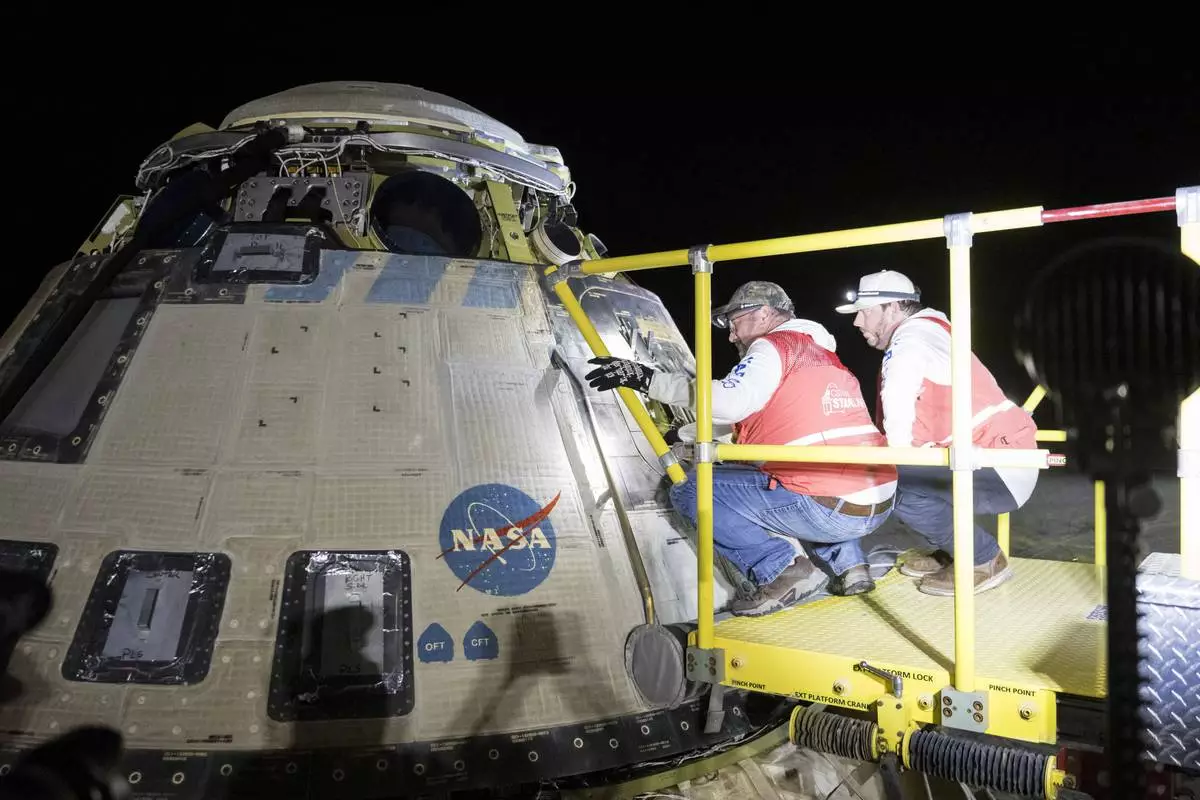
In this photo provided by NASA, Boeing and NASA teams work around NASA's Boeing Crew Flight Test Starliner spacecraft after it landed uncrewed, Friday, Sept. 6, 2024, at White Sands, New Mexico, after undocking from the International Space Station. (Aubrey Gemignani/NASA via AP)
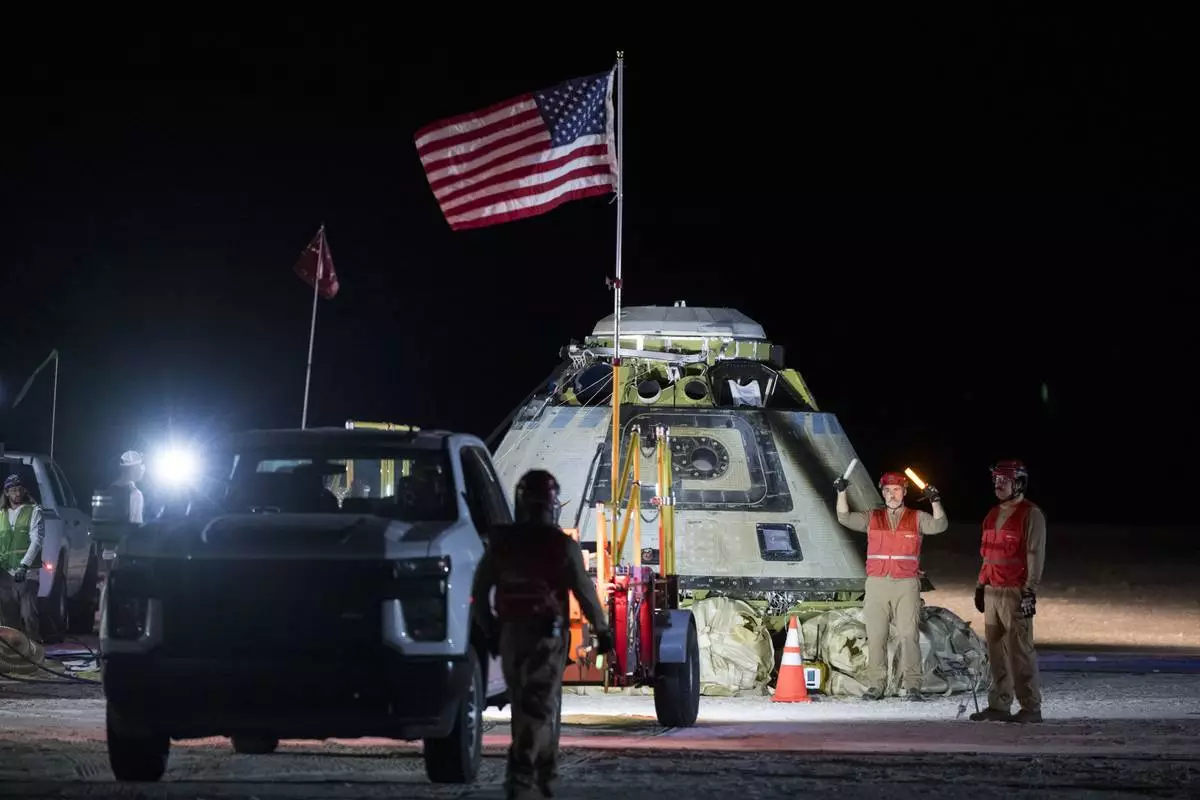
In this photo provided by NASA, Boeing and NASA teams work around NASA's Boeing Crew Flight Test Starliner spacecraft after it landed uncrewed, Friday, Sept. 6, 2024, at White Sands, New Mexico, after undocking from the International Space Station. (Aubrey Gemignani/NASA via AP)
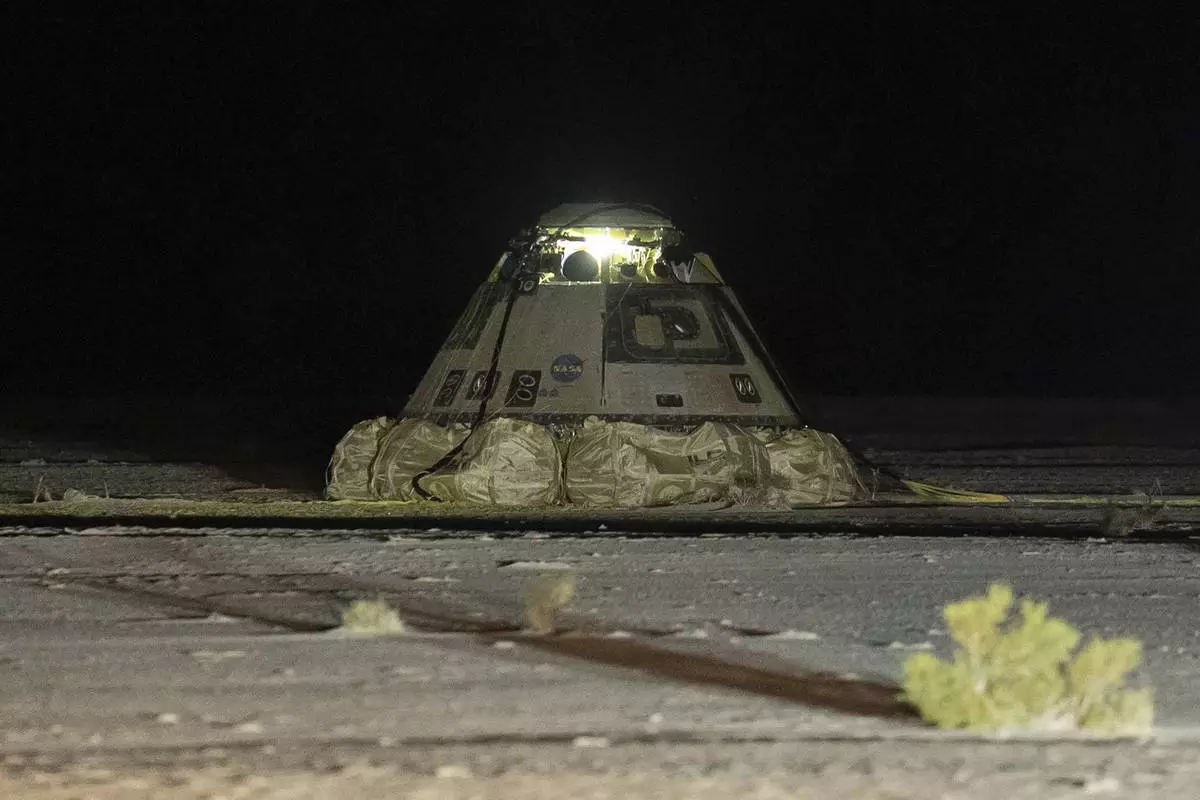
The empty Boeing Starliner capsule sits at White Sands Missile Range in New Mexico, late Friday, Sept. 6, 2024, after undocking from the International Space Station. (Boeing via AP)

In this image from video provided by NASA, the empty Boeing Starliner capsule jettisons its heat shield, bottom, before touching down at White Sands Missile Range in New Mexico late Friday, Sept. 6, 2024, after undocking from the International Space Station. (NASA via AP)
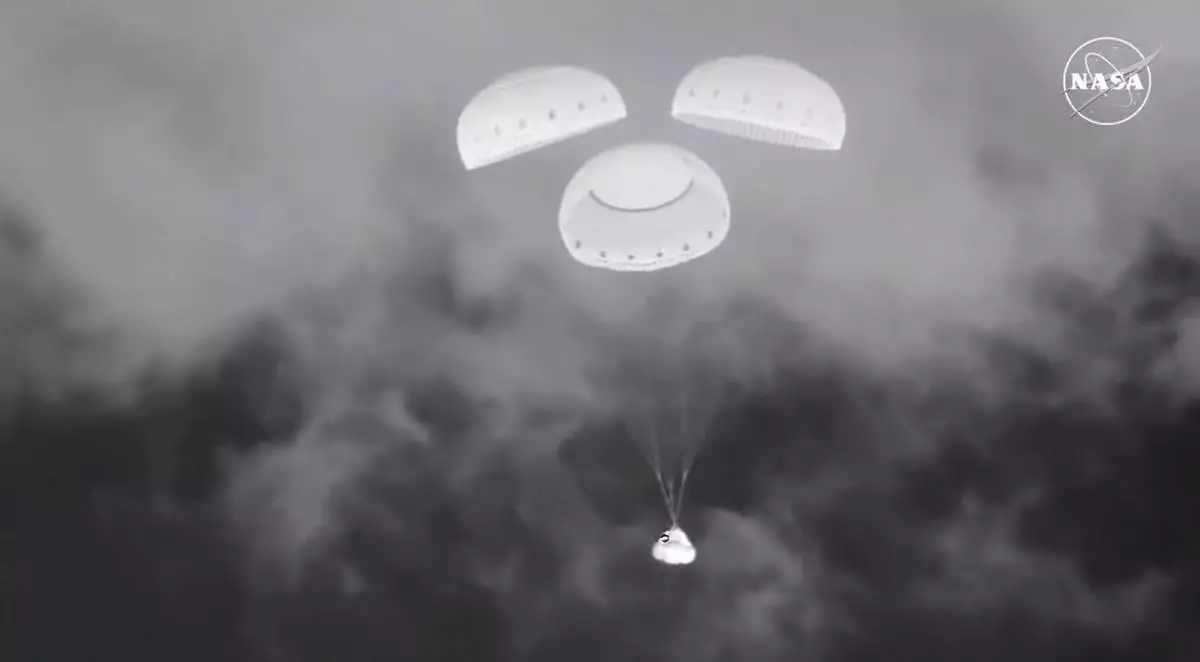
In this image from video provided by NASA, the empty Boeing Starliner capsule floats down towards White Sands Missile Range in New Mexico late Friday, Sept. 6, 2024, after undocking from the International Space Station. (NASA via AP)
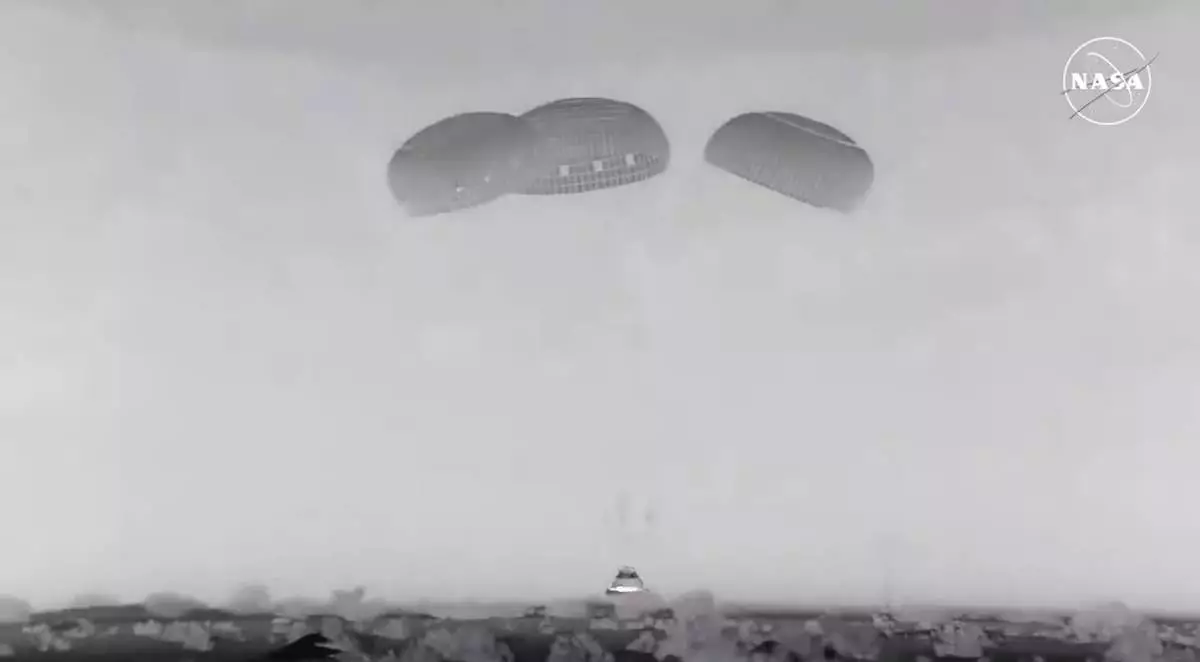
In this image from video provided by NASA, the empty Boeing Starliner capsule touches down at White Sands Missile Range in New Mexico late Friday, Sept. 6, 2024, after undocking from the International Space Station. (NASA via AP)
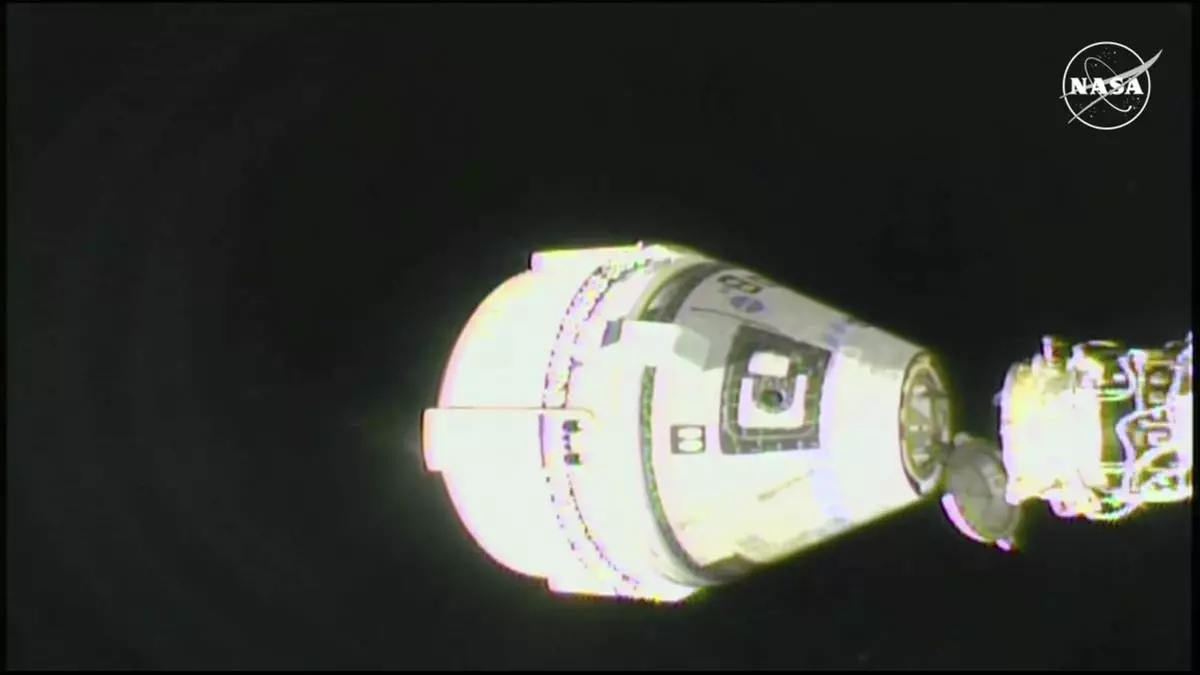
In this image from video provided by NASA, the unmanned Boeing Starliner capsule undocks as it pulls away from the International Space Station on Friday, Sept. 6, 2024. (NASA via AP)

In this image from video provided by NASA, the unmanned Boeing Starliner capsule fires its thrusters as it pulls away from the International Space Station on Friday, Sept. 6, 2024. (NASA via AP)

In this photo provided by NASA, astronauts Butch Wilmore, left, and Suni Williams inspect safety hardware aboard the International Space Station on Aug. 9, 2024. (NASA via AP)
NEW YORK (AP) — At the end of her new memoir, Hillary Clinton offers up what sounds like a far-off wish: “I hope I’m alive to see the United States elect a female president.”
Turns out her book went to the printers a tad too soon. Clinton wrote that sentence before Kamala Harris became the Democratic presidential nominee, suddenly making that wish feel a whole lot more immediate. It was too late to update the print version of “Something Lost, Something Gained,” which comes out this week, though the audiobook now has an epilogue.
So how does Clinton feel about that wish now?
“Really optimistic,” she says, praising the vice president as a candidate and in particular her recent debate performance. “I think I’m going to be around to see the first woman president!”
Clinton, 76, has written memoirs before – from “Living History” in 2003 up through “What Happened?” in 2017, about the painful loss to Donald Trump that thwarted her own quest to be the first female U.S. president. This latest feels more intimate. Inspired by the song “Both Sides Now” by one of her favorite musicians, Joni Mitchell, the book aims to be a snapshot of how she sees the world now, she says — rather like catching up with her over dinner.
So it goes from the macro – for example, a chapter on how she imagines the years following a Trump re-election, starting with troops patrolling America’s cities – to the micro, describing life as a grandmother or mornings at home with Bill, competing over the Spelling Bee puzzle in The New York Times.
First lady, lawyer, senator, secretary of state, and of course presidential nominee. University professor, fledgling Broadway producer. Clinton has lived many chapters, and the book’s actual chapters shift easily between eras.
She recounts in spy-novel-worthy detail an operation to save threatened women in Afghanistan as the Taliban were taking over in 2021, then reflects in the next chapter on the unique “sisterhood” of former first ladies, at one point defending Melania Trump from criticism of her attire at Rosalynn Carter’s memorial service: “She came. That’s what mattered.”
But she makes no secret of her animosity toward Donald Trump. It’s clear that in the “something lost” category of her title is the election that still hurts, deeply. In one recent anecdote, she recounts running into a retired FBI official who apologized for his role in how the bureau handled the investigation over her emails, a probe that was reopened days before the election.
She writes that she stared for a minute, unable to speak. “I would have been a great president,” she then told him, before walking off.
Clinton spoke to The Associated Press last week ahead of her book’s release. Some more takeaways:
Clinton wore white, honoring women’s suffrage, when she accepted the Democratic nomination; Harris did not. Clinton spoke of “18 million cracks” in the ultimate glass ceiling when she lost; Harris has not emphasized gender in her speeches. Why the difference?
Well, says Clinton, it’s been eight years. When she ran, it was so new for the country to have a female major-party candidate that it had to be a focus. Nearly a decade later, the country’s gotten more used to the idea.
”We now don’t just have one image of a person who happens to be a woman who ran for president – namely me,” she said. “Now we have a much better opportunity for women candidates, starting with Kamala, to be viewed in a way that just takes for granted the fact that yes, guess what? She’s a woman.”
Clinton writes that admirers often come up to her and say “You warned us, and I wish we had listened.” (She adds: “What am I supposed to say to that? Yes, I did.”)
But Clinton also writes that she takes no pleasure in hearing or feeling she was right – “in fact, I hate it” – even when she learned one afternoon in May that Trump had become the first former U.S. president to be convicted of felony crimes, a moment she says brought “a jolt of disbelief” and “a pang of vindication” plus some tears.
Asked what she is most afraid of “being right” about now, she replies: "I’m most afraid that people will not take Donald Trump seriously. And literally.”
Not surprisingly for the woman who coined the phrase “Women’s rights are human rights” three decades ago, Clinton writes about many female activists and dissidents she’s worked with around the globe. She also tells the story of how she joined with colleagues in a secret operation to get hundreds of women out of Afghanistan – professors, lawyers, activists and their families – who were likely to be targeted by the Taliban once U.S. troops left.
But Clinton also discusses new pursuits. Like teaching, for the first time in 50 years, at Columbia University. And Broadway producing. Clinton was among the producers of “Suffs,” the Tony-winning musical about women who fought for the right to vote in the early 20th century. She ends her book with a song from the show, “Keep Marching.”
Is there more producing in the future? “I don’t know,” she says. “I can tell you it’s been one of the greatest experiences in my life.”
Being a grandmother “truly is the one experience of life that is not overrated,” says the grandmother of three, who dedicates her book to them.
But Clinton gets most personal when addressing her marriage, which she says brings her “new joys every day.” She does not feel the need to elaborate on her reference to past challenges. “It’s no secret that Bill and I had dark days in our marriage in the past,” she writes. “But the past softens with time, and what’s left is the truth: I’m married to my best friend.”
Asked now if she feels some people still don’t believe that, and wonder why she stayed, she replies: “I’m sure there are people who don’t get it. (But) this was for me an opportunity to basically say what I believe, which is that every life has challenges, opportunities, setbacks, disappointments, successes, achievements. And you have to make a decision almost every day about how you’re going to live that day.” Hers, she says, were right for her.
Clinton’s schedule is organized by an aide, to the minute. A phone call might be planned for 10:14 a.m. But what does that mean about her much-documented walks in the woods near home in Chappaqua, New York.
Clinton schedules time for those, too. Sometimes Bill comes, but his walks are more like “an ambling conversation” where he needs to chat with everyone they see. As for her, she needs to “just get out and walk as fast as I can.”
Sometimes she plans speeches while walking. Other times, she says, she thinks about absolutely nothing. “The Japanese have this great phrase that translates to forest bathing, where you just literally walk in the woods and just take it all in.”
She advises readers to do the same when the political climate starts to overwhelm: “Put down your phone and go outside. Take a walk.”
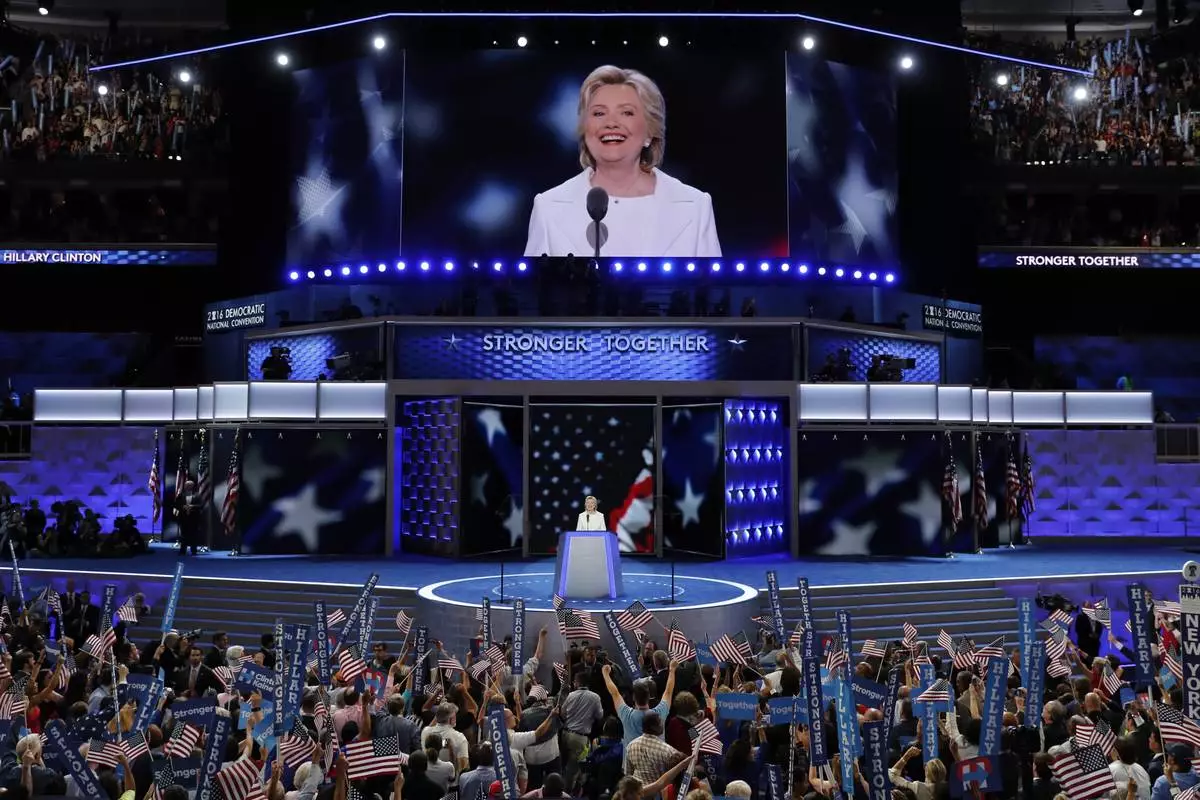
FILE - Democratic presidential nominee Hillary Clinton speaks during the final day of the Democratic National Convention in Philadelphia, July 28, 2016. (AP Photo/J. Scott Applewhite, File)

This cover image released by Simon and Schuster shows, "Something Lost, Something Gained: Reflections on Life, Love, and Liberty," by Hillary Rodham Clinton. (Simon and Schuster via AP)












